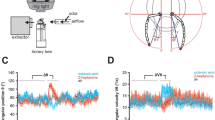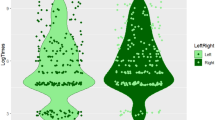Abstract
Cognitive ethology focuses on the study of animals under natural conditions to reveal ecologically adapted modes of learning. But biologists can more easily study what an animal learns than how it learns. For example, honeybees take repeated ‘orientation’ flights before becoming foragers at about three weeks of age1. These flights are a prerequisite for successful homing.2 Little is known2,3 about these flights because orienting bees rapidly fly out of the range of human observation. Using harmonic radar, we show for the first time a striking ontogeny to honeybee orientation flights. With increased experience, bees hold trip duration constant but fly faster, so later trips cover a larger area than earlier trips. In addition, each flight is typically restricted to a narrow sector around the hive. Orientation flights provide honeybees with repeated opportunities to view the hive and landscape features from different viewpoints, suggesting that bees learn the local landscape in a progressive fashion. We also show that these changes in orientation flight are related to the number of previous flights taken instead of chronological age, suggesting a learning process adapted to changes in weather conditions, flower availability and the needs of bee colonies.
This is a preview of subscription content, access via your institution
Access options
Subscribe to this journal
Receive 51 print issues and online access
$199.00 per year
only $3.90 per issue
Buy this article
- Purchase on Springer Link
- Instant access to full article PDF
Prices may be subject to local taxes which are calculated during checkout



Similar content being viewed by others
References
Winston, M. L. The Biology of the Honey Bee (Harvard Univ. Press, Cambridge, MA, 1987).
Becker, L. Untersuchungen über das Heimfindevermögen der Bienen. Z. Vergl. Physiol. 41, 1–25 (1958).
Vollbehr, J. Zur Orientierung junger Honigbienen bei ihrem ersten Orientierungsflug Zool. Jb. Allg. Zool. Physiol. 79, 33– 69 (1975).
Riley, J. R. et al. Tracking bees with harmonic radar. Nature 379, 29–30 (1996).
Osborne, J. L. et al. A landscape scale study of bumble bee foraging range and constancy, using harmonic radar. J. Appl. Ecol. 36, 519–533 (1999).
Capaldi, E. A. & Dyer, F. C. The role of orientation flights on homing performance in honeybees. J. Exp. Biol. 202, 1655–1666 (1999).
Collett, T. S. Landmark learning and guidance of insects. Phil. Trans. R. Soc. Lond. B, 337, 295–303 ( 1992).
Lindauer, M. Angeborne und erlernte Komponenten in der Sonnenorientierung der Bienen. Z. Vergl. Physiol. 42, 43–62 (1959).
Dyer, F. C. & Dickinson, J. A. How partially experienced bees estimate the sun's course. Proc. Natl. Acad. Sci. USA 91, 4471–4474 (1994).
Visscher, P. K. & Seeley, T. D. Foraging strategies of honeybee colonies in a temperate deciduous forest. Ecology 6, 1790–1801 (1982).
Wehner, R. in Handbook of Sensory Physiology (ed. H. Antrum), Volume VII/6c, 287–616 (Springer, New York, 1981).
White, G. C. & Garrott, R. A. Analysis of Wildlife Radio Tracking Data (Academic, New York, 1990).
SAS Stat Users Guide 6. 03 Edition (SAS Institute, Cary, North Carolina, 1988).
Zar, J. H. Biostatistical Analysis (Prentice Hall, Upper Saddle River, New Jersey, 1996).
Ribbands, C. R. The Behaviour and Social Life of Honeybee. (Bee Research Association, London, 1953).
Acknowledgements
We thank J. Drew, T. Hallam, J.C. Kuehn, C. Mata and J. Strand for field assistance in Illinois, N. Carreck for beekeeping assistance at Rothamsted, S. Aref for help with data analysis, and F.C. Dyer and the members of the Fahrbach and Robinson laboratories for reviewing this manuscript. This work was supported by the National Science Foundation, The Research Board of the University of Illinois at Urbana-Champaign, the Biotechnology and Biological Sciences Research Council of the United Kingdom, the British Beekeepers' Association, the European Community Regional Tsetse and Trypanosomiasis Control Programme, the Leverhulme Trust and the United Kingdom Department for International Development Flexibility Fund. E.A.C. was supported by a National Research Service Award from the NIH.
Author information
Authors and Affiliations
Corresponding author
Rights and permissions
About this article
Cite this article
Capaldi, E., Smith, A., Osborne, J. et al. Ontogeny of orientation flight in the honeybee revealed by harmonic radar . Nature 403, 537–540 (2000). https://doi.org/10.1038/35000564
Received:
Accepted:
Issue Date:
DOI: https://doi.org/10.1038/35000564
This article is cited by
-
Spontaneous and information-induced bursting activities in honeybee hives
Scientific Reports (2023)
-
Timing of drone flights and observations of other colony behaviors of Apis laboriosa in northern Vietnam
Apidologie (2023)
-
The potential underlying mechanisms during learning flights
Journal of Comparative Physiology A (2023)
-
Navigation and dance communication in honeybees: a cognitive perspective
Journal of Comparative Physiology A (2023)
-
Best practices for instrumenting honey bees
Scientific Reports (2022)
Comments
By submitting a comment you agree to abide by our Terms and Community Guidelines. If you find something abusive or that does not comply with our terms or guidelines please flag it as inappropriate.



